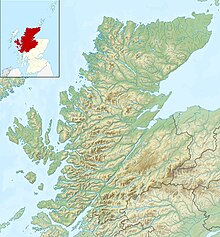| Siege of Culloden House | |||||||
|---|---|---|---|---|---|---|---|
| Part of the Jacobite rising of 1715 | |||||||
 Old Culloden House, Duncan Forbes | |||||||
| |||||||
| Belligerents | |||||||
|
|
| ||||||
| Commanders and leaders | |||||||
|
Hugh Fraser |
| ||||||
| Strength | |||||||
| Unknown | 700 | ||||||
| Casualties and losses | |||||||
| None | Unknown | ||||||
 | |||||||
| Jacobite rising of 1715 | |
|---|---|
The siege of Culloden House was part of the Jacobite rising of 1715 in Scotland.
The siege
After the Jacobites had seized Inverness, some of them marched to Culloden House which was held by the Forbes family who supported the British Government and laid siege to it. They were told by the laird's wife that if they approached within gun-shot of the house that she would show them that she had both the arms and ammunition to support the right and title of George I of Great Britain. The house was besieged for seven weeks before it was relieved. Lady Forbes of Culloden and her servants managed to hold off a force of armed men. They were relieved with the assistance of Simon Fraser, 11th Lord Lovat who dispersed the force from Clan Chattan who controlled the area which in turn enabled him to gain the support of John Gordon, 16th Earl of Sutherland and John Forbes to give him freedom from arrest for treason. The men of the Clan Chattan having given up the siege joined the main Jacobite army under John Erskine, Earl of Mar at Perth on 5 October with 700 men. According to one source, during the siege a cannon shot had hit a tree and the falling timber killed one of the Jacobie rebels, with the tree subsequently being covered in a huge growth of ivy.
During the siege of 1715, Culloden House was defended by Hugh Fraser whose brother, James Fraser of Foyers, laid siege to the house during the Jacobite rising of 1745.
References
- Youngston, A.J (1985). The Prince and The Pretender :A Study in the Writing of History. London, Sydney and Dover, New Hampshire: Croom Helm. p. 46. Retrieved 22 August 2020.
- Fraser, Sarah (2012). The Last Highlander: Scotland's Most Notorious Clan Chief, Rebel & Double Agent. London: HarperCollins. p. 143. ISBN 9780007229499.
- Henshaw, Victoria (2014). Scotland and the British Army, 1700-1750: Defending the Union. Bloomsbury Publishing. p. 109. ISBN 9781472505224. Retrieved 22 August 2020.
- Sinclair, A (1903). The Celtic Monthly: A Magazine for Highlanders. Vol. 11. p. 73. Retrieved 22 August 2020.
- Fraser, A (1897). A Catalog of The Valuable Contents of Culloden House to be Sold by Auction by Messrs A. Fraser & Co., Inverness. pp. 64-65. Retrieved 22 August 2020.
- Transactions of the Gaelic Society of Inverness. Vol. 62. 2004. p. 413. Retrieved 22 August 2020.